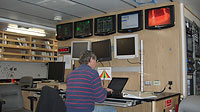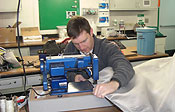

 | |||||||||||||||||||||
|
|
Journals 2008/2009Roy Arezzo
July 20, 2008 The big story on the NBP is the changing ice as we transit north. We are back into the pancake ice, similar to what we saw on our way south, and although we are certainly not heading out of winter by any stretch it did feel warmer today. It is amazing how -1° C could feel just fine with low wind and proper gear. We enlisted the fire hose to clear away Station F mud and ice to start our mud slinging with a fresh deck. Here at Station E, the Megacore also agreed with warmer temperatures and we were able to load and unload it outside without taking apart the moving parts and blasting it with the hair dryer.
I am starting to get the layout of the ship, but I am surprised at how many spots I have missed over the past 10 days at sea. Today I realized that Aquarium lab fish tank configuration had changed and the spare tank was missing. It turns out that it was moved and rigged for an experiment that I knew nothing about, in a place I had not been. There is now an aquarium set up in the dark of the cold room to monitor feeding behavior in our bottom-dwelling animals. Three separate species of "sea cucumber" from our Box Core samples are being fed enriched algae labeled with carbon-13. Scientists from North Carolina State University will later test the animal's gut and tissues and determine where the carbon-13 ends up. We are interested in how much feeding they do and how quickly the algae are converted into body tissue, which will help us understand metabolic rates and growth. As for laboratory facilities on this research vessel, scientists occupy about 10 different spaces on any given day. Most of the laboratory spaces are on the main deck along with the galley and access to the back deck. Almost all the deployment activities happen off the back deck area which is L shaped, and constructed with additional winches and an A frame both at the stern and the starboard side. The marine technicians who run the deck operations have a shop/office off of the back deck and as you move forward through the ship the first space for science is called the aquarium lab. Since the floor of this space has a grating and is designed to drain we do much of our dirty work in this space and it has a built in trunk-sized chamber that circulates water to store live organisms. We make good use of the aquarium lab bench-tops to prepare our cores samples for experimentation and the seawater hoses to wash away the mud from our equipment. To the port and forward of the aquarium lab are the hydro lab and the wet lab. The hydro lab is where we take water samples to process for nutrients and it houses some of the analysis instruments. The wet lab is a mixed-use space where samples are processes and some of the camera equipment we deploy gets stored and worked on. Forward of the wet lab is the Baltic room which is home to the CTD (conductivity, temperature and depth sensors) water sampler. This room is equipped with a separate winch and a starboard bay door so the CTD can be stored indoors and deployed regularly from a separate space allowing us to do back to back deployments more fluidly.
As you move forward you come to two cold environmental rooms that look like walk-in freezers, but have bench tops for lab work. Antarctic samples often have to remain cold (around 0° C) for experimentation. We use one of these spaces for dissection. The bio lab is typical laboratory space with bench tops and fumes hoods and across from the bio lab is the aft dry lab, which is where we store a lot of our lab materials. The dry lab has a good assortment of bench tops and counters with cabinets and serves as a good multi-use space. The forward dry lab is essentially a computer room and serves as a command center for the scientists to watch the monitors and communicate with the bridge. Across the hall is the Electronics lab which also has computers for general use and office space for the IT folks and the electronics technicians. There is a microscope room on the first deck but we mostly use the microscope mounted in the dry lab to check out our plankton.
Since I find myself both in the lab and on deck often, I have started using the mud room near the wet lab to get in and out of gear. When equipment is on its way up to the surface, I often feel like a fireman as I rush into the mudroom and jump into my safety wear. I am equipped with steel toe fireman boots and waterproof overalls to throw over my regular thermals and work clothes. On top, I wear the standard mustang float coat with reflective markings, fleece coat, a hat, neck gator, waterproof gloves and a hard hat. There is the full jumpsuit mustang suit option but I find a bit too warm and difficult to get in and out of so I opt for the two-piece. Proper attire is mandatory on deck. |
||||||||||||||||||||




